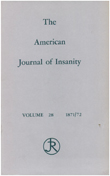High-resolution SPECT study of regional cerebral blood flow in drug- free and drug-naive schizophrenic patients
Abstract
OBJECTIVE: The purpose of the study was to compare regional cerebral blood flow (CBF) in schizophrenic patients never treated with psychotropic drugs (drug-naive) and in schizophrenic patients free from drugs for various amounts of time. METHOD: Seventeen schizophrenic patients (nine who were drug naive and eight who had been drug free for at least 3 weeks) and 12 healthy volunteers were included in the study. Regional cerebral perfusion was studied with the use of a head- dedicated, high-resolution single photon emission computed tomography (SPECT) system. Cerebral SPECT scans were performed with technetium-99m- hexamethyl-propyleneamine oxime as a tracer. Regional CBF was measured as a ratio of regional tracer uptake to either cerebellar or whole brain tracer uptake. RESULTS: When the cerebellum was taken as the reference region, the drug-naive patients showed a significant bilateral reduction of perfusion in the mesial, dorsolateral, and basal prefrontal cortex, in the temporal cortex, and in the subcortical gray structures: thalamus, caudate nucleus, and putamen/pallidum complex. No significant differences emerged in the comparison between the drug-free patients and the healthy subjects. With correction for whole brain activity, some of the differences that had been found disappeared, but a significant hypoperfusion persisted in the basal ganglia and thalamus of the drug-naive, but not the drug-free, patients. Few correlations between symptom presentation and regional CBF perfusion were observed in the schizophrenic patients. CONCLUSIONS: These results suggest a pattern of cerebral hypoperfusion in schizophrenic patients never treated with neuroleptics that was not detectable in patients who had undergone various periods of pharmacological washout.
Access content
To read the fulltext, please use one of the options below to sign in or purchase access.- Personal login
- Institutional Login
- Sign in via OpenAthens
- Register for access
-
Please login/register if you wish to pair your device and check access availability.
Not a subscriber?
PsychiatryOnline subscription options offer access to the DSM-5 library, books, journals, CME, and patient resources. This all-in-one virtual library provides psychiatrists and mental health professionals with key resources for diagnosis, treatment, research, and professional development.
Need more help? PsychiatryOnline Customer Service may be reached by emailing [email protected] or by calling 800-368-5777 (in the U.S.) or 703-907-7322 (outside the U.S.).



